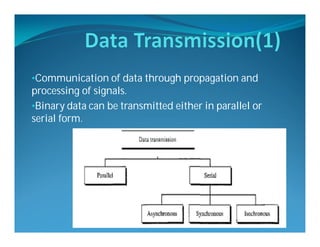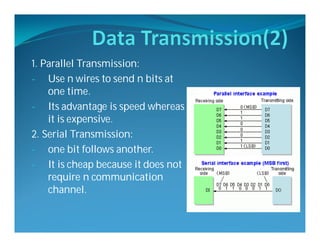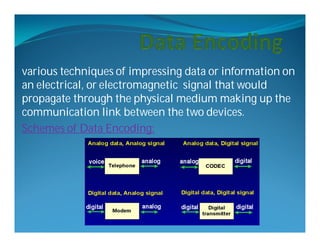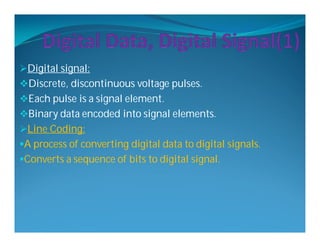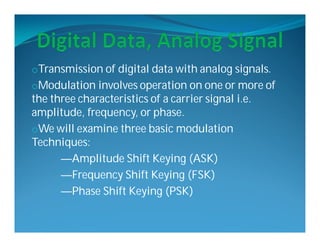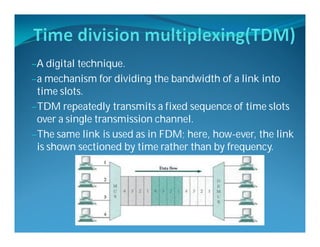Data Communication Principles
- 1. Prepared by: Kind Kishor Tribhuvan University
- 2. Analog and digital data. Analog and digital signal. Transmission impairment. Channel capacity. Data transmission. Data encoding. Multiplexing.
- 3. Analog data – representation variable takes on continuous values in some interval. e.g. voice, temperature, etc. Digital data – representation variable takes on discrete(a finite & countable number of) values in a given interval. e.g. text, digitized images, etc.
- 4. Electric or electromagnetic representation of data. The signal intensity varies in a smooth fashion over a time, or no breaks in the signal. Has infinitely many levels of intensity over a period of time. The signal intensity maintains a constant level for some period of time then changes to another constant level. Has only a limited number of defined values.
- 5. periodic signal – completes a pattern within some measurable time frame, called a period , and then repeats that pattern over subsequent identical periods. Aperiodic signal – changes without exhibiting a pattern that repeats over time. a. Periodic analog signal b. Periodic digital signal
- 6. Periodic analog signals are two types i.e. simple and composite analog signal. Simple Analog Signal – cannot be decomposed into simpler signals. Composite Analog Signal – composed of multiple sine waves. Sine wave – most fundamental form of periodic analog signal. It can be represented by 3 parameters: peak amplitude, frequency, and phase. Mathematically, s(t) = A⋅sin(2πft +ϕ) Where, S=instantaneous amplitude A=peak amplitude F=frequency Φ=phase
- 7. 1. Peak amplitude (A ):- absolute value of signal’s highest intensity . unit: volts [V] 2. Period and Frequency(f):-number of periods in one second where period is amount of time to complete 1 cycle. unit: hertz [Hz] 3. phase (φ):-absolute position of the waveform relative to time 0. unit: degrees [º] or radians [rad] where 360º = 2π rad Bandwidth: The range of frequency that a medium can pass i.e. Difference between highest and lowest frequency that channel can satisfactorily pass.
- 8. sequence of voltage pulses. each pulse represents a signal element. Most digital signals are aperiodic. Key digital-signals terms: • bit interval – time required to send a single bit, unit: [sec] • bit rate – number of bit intervals per second – unit: [bps] A digital signal with two levels.
- 9. Property of a transmission medium which causes the signal to be degraded, reduced in amplitude, distorted or contaminated. The causes are: –Attenuation: loss of energy as the signal propagates outwards. –Distortion : the signal changes its form or shape i.e. phase. –Noise :
- 10. The maximum rate at which data can be transmitted over a given communication path or channel under given conditions. Data rate, bandwidth, noise, and error rate are involved in the evolution of channel capacity. Shannon Capacity Formula: Introduced by Claude Shannon in 1994. To determine highest data rate for a noise channel. Unit-bps(bit per second). Capacity= Where, B=bandwidth SNR=signal-to-noise ratio(S/N)
- 11. •Communication of data through propagation and processing of signals. •Binary data can be transmitted either in parallel or serial form.
- 12. 1. Parallel Transmission: ‐ Use n wires to send n bits at one time. ‐ Its advantage is speed whereas it is expensive. 2. Serial Transmission: ‐ one bit follows another. ‐ It is cheap because it does not require n communication channel.
- 13. 1. Asynchronous Transmission:- information is received and translated by agreed upon patterns. Patterns are based on grouping the bit stream into bytes. 2. Synchronous Transmission:- the bit stream is combined into longer ‘frames’ which may contain multiple bytes. Timing becomes very important. 3. Isochronous Transmission:- A form of data transmission that guarantees to provide a certain minimum data rate, as required for time- dependent data such as video or audio.
- 14. various techniques of impressing data or information on an electrical, or electromagnetic signal that would propagate through the physical medium making up the communication link between the two devices. Schemes of Data Encoding:
- 15. Digital signal: Discrete, discontinuous voltage pulses. Each pulse is a signal element. Binary data encoded into signal elements. Line Coding: A process of converting digital data to digital signals. Converts a sequence of bits to digital signal.
- 16. i. Signal element v/s Data element:- data element is smallest entity that can represent a piece of information whereas signal element is the shortest unit of a digital signal. ii. Data rate v/s Signal rate:- data rate(bit rate)is number of data element(bit) sent in 1(s) whereas signal rate(pulse rate) is number of signal element sent in 1(s). iii. DC Components:- frequencies around zero. iv. Self-Synchronization:- correctly interpret the signals received from the sender.
- 18. Unipolar: all signal levels are on one side of the time axis either above or below. Positive voltage defines bit 1 and zero voltage defines bit 0. Polar: signal levels are both side of the time axis. Voltage level for 0 can be positive and for 1 can be negative. It can be further divided into four categories.
- 19. • Two different voltages for 0 and 1 bits • Negative voltage for one value and positive for the other, eg. —Binary 0 : Positive —Binary 1 : Negative • Voltage constant during bit interval —no transition i.e. no return to zero voltage L
- 20. •Uses three values: positive, negative, and zero. •The signal goes to 0 in the middle of each bit and remains there until the beginning of the next bit.
- 21. oThe duration of bits is divided into two halves. oThe voltage remains at one level during 1st half and moves to another level in the second half. oTransition occurs at the middle of each bit period oTransition serves as clock and data oLow to high represents binary 1 oHigh to low represents binary 0
- 22. ›Combines the ideas of RZ and NRZ-I. ›There is always transition at the middle of the bit. ›The bit values are determined at the beginning of the bit. ›There is a transition when next bit is 0. ›There is no transition when next bit is 1.
- 23. oTransmission of digital data with analog signals. oModulation involves operation on one or more of the three characteristics of a carrier signal i.e. amplitude, frequency, or phase. oWe will examine three basic modulation Techniques: —Amplitude Shift Keying (ASK) —Frequency Shift Keying (FSK) —Phase Shift Keying (PSK)
- 24. Values represented by different amplitudes of carrier. Usually, one amplitude is zero i.e. presence and absence of carrier is used. Frequency and phase remain constant.
- 25. The frequency of the carrier signal is varied to represent data. Frequency of the modulated signal is constant for the duration of one signal element, but changes for the next signal element if the data element is changed. Peak amplitude and phase remain constant for all signal element.
- 26. oThe phase of the carrier signal is varied to represent binary 0 or 1. oTwo phases represent two binary digits. oBoth peak amplitude and frequency remain constant.
- 27. set of techniques that allows the simultaneous transmission of multiple signals across a single data link. n lines share the bandwidth of one link. Three are three basic multiplexing techniques:
- 28. ‐An analog technique. ‐It can be applied when the bandwidth of a link is greater than the combined bandwidths of the signals to be transmitted. ‐ a scheme in which numerous signals are combined for transmission on a single communications line or channel. ‐Each signal is assigned a different frequency (subchannel) within the main channel. When FDM is used in a communications network, each input signal is sent and received at maximum speed at all times i.e. bandwidth is greater.
- 29. –An analog technique. – A method of combining multiple signals on laser beams at various infrared (IR) wavelengths for transmission along fiber optic media. –A technique for using a fiber (or optical device)to carry many separate and independent optical channels. WDM is conceptually the same as FDM, except that the multiplexing and de-multiplexing involve optical signals transmitted through fiber-optic channels.
- 30. –A digital technique. –a mechanism for dividing the bandwidth of a link into time slots. –TDM repeatedly transmits a fixed sequence of time slots over a single transmission channel. –The same link is used as in FDM; here, how-ever, the link is shown sectioned by time rather than by frequency.
- 31. The End







![1. Peak amplitude (A ):- absolute value of signal’s highest intensity .
unit: volts [V]
2. Period and Frequency(f):-number of periods in one second where
period is amount of time to complete 1 cycle. unit: hertz [Hz]
3. phase (φ):-absolute position of the waveform relative to time 0. unit:
degrees [º] or radians [rad] where 360º = 2π rad
Bandwidth:
The range of frequency that a medium can pass i.e. Difference
between highest and lowest frequency that channel can
satisfactorily pass.](https://image.slidesharecdn.com/unit-2datacommunicationprinciples-140428103013-phpapp01/85/Data-Communication-Principles-7-320.jpg)
![sequence of voltage pulses.
each pulse represents a signal element.
Most digital signals are aperiodic.
Key digital-signals terms:
• bit interval – time required to send a single bit, unit: [sec]
• bit rate – number of bit intervals per second – unit: [bps]
A digital signal with two levels.](https://image.slidesharecdn.com/unit-2datacommunicationprinciples-140428103013-phpapp01/85/Data-Communication-Principles-8-320.jpg)


